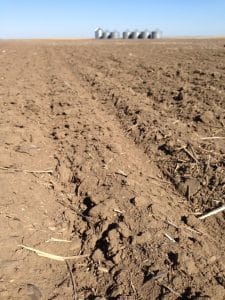
In dry soil conditions, growers may be tempted to seed deep enough to reach moisture. This is not necessary from April to mid-May, and may create more harm than good at any time. The common recommendation to seed no deeper than 1” still applies in dry conditions. Here’s why:
—In April and through to mid May, there is still time to wait for a rain to provide the moisture needed for germination and emergence.
—Going deeper to reach moisture also means cooler soil. Cool conditions combined with the extended distance seedlings must grow to reach the soil surface will mean higher seed and seedling mortality. Higher seeding rates will be needed to compensate.
—Deep seeding guarantees that some will go into secondary dormancy. Dormant seed will not germinate this year, and will add to the volunteer canola seed bank.
—Deep seeding allows weeds emerging at the same time to get ahead of the crop. Shallow seeding is a good integrated weed management technique.
Things to consider:
Field topography. Shallow seeding into dry hilly land may result in uneven emergence if seeds in low spots have enough moisture to germinate even without a rain event. However, in these fields, deep seeding to reach moisture may not necessarily be an improvement. Uneven emergence is still a strong possibility. The good news is that seeds emerging first in these lower areas may mature later due to better moisture and fertility, so in the end, differences in emergence
date between low spots and hill tops may even out later in the season.
Soil type. Growers may get away with deeper seeding — at 1” instead of 1/2” — in lighter soils. Sandier soil tends to dry out faster on top, so moisture and seedbed conditions would be better at this slightly deeper depth.
The tillage effect. In tilled fields, the top layer will be dusty in dry conditions, so seeding at 1” instead of 1/2” could be a benefit. Soil temperature at depth will also be warmer in worked soil, which may reduce the cold soil effect on germination, although this effect will be minimal by late May.
Seeding rate. Seeding deeper than recommended will often require a higher seeding rate to meet target plant stands, given that seedling mortality will be higher in deep soils — especially with the added stress of dry conditions.
Seed-placed fertilizer. In dry conditions, the risk of seed and seedling loss from fertilizer is higher. Consider lowering the rates of seed-placed fertilizer in dry conditions.
If dry conditions continue into late May…
Seeding depth strategy can change with the warm soils of late May. Seeding deeper to hit moisture will hasten germination and crop establishment in fields where the top 1” is too dry to allow germination and emergence.
Here are some tips:
Seed doesn’t have to be IN moisture. ON moisture is OK when seeding deeper, because the additional soil above the seed row slows that moisture loss. Make sure the seed row is well packed to seal in that moisture, allow for some moisture migration, provide good seed-to-soil contact, and prevent further drying out.
Recognize that deeper seeding will increase seed and seedling mortality. Add 10% to the seeding rate to compensate.
Deeper seeding can increase seedling disease risk. Part of the increased mortality with deep seeding is due to increased exposure to seedling pathogens. Deeper seeding means more plant material underground — material that is exposed to pathogens. Seedlings stressed to reach the surface due to deep seedling may also be more vulnerable to disease. This seedling disease risk can be higher in fields with canola in shorter rotations.
Put starter phosphate in the seed row. Keep to the recommended safe rates of phosphorus, probably about 20 pounds of actual phosphate per acre — or lower depending on your seedbed utilization. The nitrogen component of ammonium phosphate can damage seed and seedlings at rates higher than that.
Consider the crusting risk. For heavier soils, a rain before canola emergence could create a crust above the seed row. Because deep seeded canola tends to take longer to emerge, the risk of rain before emergence is higher. Bare soils are more prone to crusting than soils with higher surface residue. With wet conditions, growers may have tilled or harrowed soils that they may not have tilled in the past. In this case, the risk of crusting may be increased relative to past experience.
Heavy rain could also fill in drill runs. Instead of 1.5” of soil cover, it could be 3” if the drill and packer combination creates a deep seed trench that fills with mud after a rain.
Slow down when seeding deep to more closely manage seed depth for all rows. At higher speeds, back rows tend to throw more dirt over the front rows.

